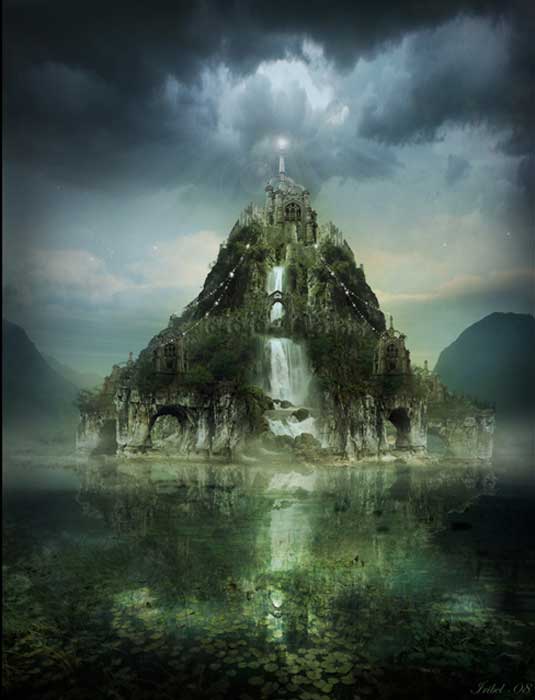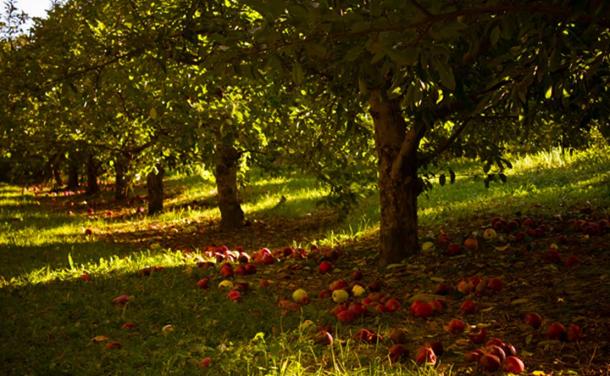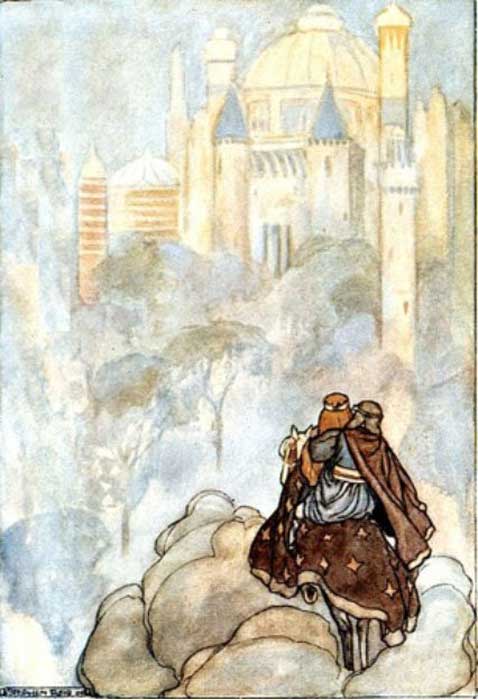Avalon: A Real Island Obscured by Legend, or Just a Legendary Island?
Like many mythical paradise isles, Avalon has captured the imagination of generations of writers since the island was first mentioned by Geoffrey of Monmouth in his Historia Regum Britanniae or History of the Kings of Britain, written in 1136 AD. Many explorers and thinkers have tried to find the actual location of the legendary island, suggesting places in the Atlantic, the Mediterranean, and even places in the southern hemisphere. Some of the most popular suggestions for the location of Avalon include the Isle of Man and Glastonbury. Despite the popularity of the idea, there does not seem to be much evidence that Avalon was based on a real place and it may have been little more than a myth derived from earlier Celtic myths about otherworldly paradise islands.

An artist’s interpretation of Avalon. (Timflanaganauthor)
The Origins of Avalon
According to the original legend, Avalon was an island full of wild apple trees, grapevines, and grain plants - which grew there instead of wild plants. Because of this, the people who lived there did not have to farm and lived out an idyllic existence. The name ‘Avalon’ in fact is related to the Proto-Celtic word “abal” meaning apple. The inhabitants of the island were also said to have very long lifespans. After King Arthur was mortally injured at the Battle of Camlann while fighting Mordred, legends say he was placed on a barge which took him to the island of Avalon. While there, King Arthur was healed and nourished back to health. It is said that King Arthur still remains there, alive, and will one day return when England needs him the most.
Voyage of King Arthur and Morgan Le Fay to the Isle of Avalon, Frank William Warwick Topham (1838-1924). (Public Domain)
Glastonbury, a Popular Suggestion for Avalon
One of the most popular options for the location of Avalon is the town of Glastonbury. Though not an island today, Glastonbury used to be high ground surrounded by marsh, making it a veritable island. Originally, a boardwalk across the marsh was the only entrance to Glastonbury. Until 1539, it was the site of the Glastonbury Abbey. Glastonbury Abbey is a famous pilgrimage site associated with early Christianity as well as the Arthurian legends. According to local legends, the abbey was founded by Joseph of Arimathea and visited by Jesus himself. Glastonbury became associated with the Arthurian legends when, in 1190 AD, the monks claimed that they had found the tomb of King Arthur and his wife Guinevere, as well as a cross carving which identified the tomb as such. This discovery brought many pilgrims who came to see the tomb of King Arthur, since he was considered to be a paragon of chivalry and a Christian hero.
- The Bewitching Tale of Morgan le Fay, a Captivating Character of Arthurian Legend
- Glastonbury Tor, England
- Manannan Mac Lir: God of the Sea and Guardian of the Afterlife

Avalon? The flat Somerset Levels are dominated by Glastonbury Tor. (Josep Renalias/ CC BY SA 3.0)
Glastonbury remains popular today as a pilgrimage and tourist site and many believe that it is in fact the final resting place of King Arthur. Despite the popularity of the idea, there doesn’t appear to be much evidence for a connection to the Arthurian legends prior to 1190. Most archaeologists consider the cross figure referring to King Arthur’s tomb to be a forgery made by the monks in order to raise funds to rebuild their abbey after it was burned down in 1184. Historical studies have also shown that the old name for the area was not Avalon but Ineswitrin.

"Leaden cross found in Arthur's grave, Glastonbury." Some suggest that this cross shows that Glastonbury is the Avalon of Arthurian legends. (Public Domain)
Avalon and the Isle of Man
Another suggested location, though less popular, is the Isle of Man because of its association with Emain Ablach which roughly translates “island of apple trees.” Emain Ablach was said to be the abode of Manannan mac Lir, the Irish god of the sea. The island was also said to be a realm of healing where youth was eternal and where there was no winter. Legends say it also contained large forests of wild apple trees. Avalon was associated with apple trees and healing too, so it seems reasonable to suggest that the Arthurian idea of Avalon was inspired by the earlier Celtic myth about Emain Ablach.
For many centuries, Emain Ablach was identified with Isle of Man because the name of the island seems to suggest a connection to the Manannan. The problem with this idea though, is that the name of the Isle of Man actually has no relation at all to the Celtic sea deity. If the association with Manannan is removed, there is little reason to suggest that the Isle of Man has anything to do with Emain Ablach - let alone Avalon.

A plentiful apple orchard. Porshe Brosseau. (Porsche Brosseau/CC BY 2.0) Both Avalon and the Isle of Man allegedly had plenty of apple trees.
Is Avalon in the Otherworld?
Although it is possible that the legend of Avalon was based on a real island, there doesn’t appear to be any evidence to connect it to a real place. It is possible, based on this lack of evidence, that Avalon was never a real island, but rather was a Christianization and “Britonization” of the pre-Christian Irish legend of Emain Ablach. This is reasonable considering the association of Avalon with apple trees, healing, and rejuvenation. Among the ancient Celts, apples were believed to have magical healing properties and the property of rejuvenation. The idyllic nature of Avalon also might reflect the ancient pre-Christian British and Irish view of the afterlife. The Irish and British believed that islands could be portals to the otherworld where souls of the dead dwelled in eternal youth and eternal bliss.

Oisín and Niamh travelling to Tír na nÓg ("Land of the Young" – an otherworld inhabited by the Tuatha Dé Dannan), illustration by Stephen Reid in T. W. Rolleston's The High Deeds of Finn (1910). (Public Domain) Was Avalon based on a similar idea?
In light of this belief in the otherworldly nature of some islands, it is conceivable that trying to find the actual location of Avalon might be pursuing the wrong question. Perhaps Avalon was never supposed to be perceived as an island existing in this world in the first place. The ancient Celts believed that these mythical islands existed in a different realm. It is possible that this was also the nature of the island to which King Arthur was taken, if the story of Avalon is indeed derived from earlier Celtic stories. As such, it cannot be found in the real world because it is in a different world entirely.
Top Image: Glastonbury tor, a location that has often been associated with Avalon. Source: The Significance of R
By Caleb Strom
References
“Manannan.” Timeless Myths. Available at: http://www.timelessmyths.com/celtic/danann.html#Manannan
“Isle of Avalon.” Legend of King Arthur. Available at: http://www.legendofkingarthur.co.uk/arthurian-places/avalon.htm
“Emain Ablach.” Oxford Review. Available at: http://www.oxfordreference.com/view/10.1093/oi/authority.20110803095749390
“Tree Lore: Apple.” By Susa Morgan Black. Library of the Order of Bards, Ovate, and Druids. Available at: http://www.druidry.org/library/trees/tree-lore-apple
Glastonbury in Norris J. Lacy, Editor, The Arthurian Encyclopedia (1986 Peter Bedrick Books, New York).





















Comments
One thing about names is that in early history names are spelt as they’re pronounced, there could be dozens of different names for the same place at the same time, each sounding the same. Add to that the amount of languages that have existed in the UK, you’ve got a few variables to search for. And we have a myth in Cornwall “According to Cornish legend King Arthur did not die after his last battle but rather his soul migrated into the body of a red-billed chough, the red colour of its bill and legs being derived from the blood of the last battle and hence killing this bird was unlucky. Legend also holds that after the last Cornish chough departs from Cornwall, then the return of the chough, as happened in 2001, will mark the return of King Arthur” My guess is that Avalon either had alot of choughs or they were special there in some way.
In Anglia et Cornubia.